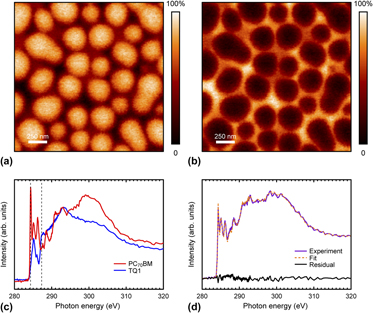Article contents
Opportunities and challenges in probing local composition of organic material blends for photovoltaics
Published online by Cambridge University Press: 14 February 2017
Abstract

Probing the distribution of donor and acceptor molecules in the active layer of polymer solar cells requires high-resolution methods that provide chemical contrast. A combination of the synchrotron-based soft X-ray technique near-edge X-ray absorption fine structure (NEXAFS) spectroscopy and scanning transmission X-ray microscopy (STXM) can map surface composition and local composition in lateral phase-separated domains, as well as identify molecular signatures of degradation. Here we illustrate, by way of selected results, the relevance of these complementary techniques to the field of organic photovoltaics. We demonstrate firstly that the determination of local composition from X-ray absorption spectra requires cautious use of fitting techniques. Furthermore, we show that drop-like clusters of PC70BM formed during the transfer of spin-coated polymer:PC70BM blend films onto Cu-grids lead to an underestimation of PC70BM/polymer concentration ratios. Finally, we show that the selective degradation of one of the components can impair the accurate determination of local blend composition.
Keywords
- Type
- Invited Article
- Information
- Journal of Materials Research , Volume 32 , Issue 10: Focus Issue: Microstructural Characterization for Emerging Photovoltaic Materials , 26 May 2017 , pp. 1982 - 1992
- Copyright
- Copyright © Materials Research Society 2017
Footnotes
Contributing Editor: Dean DeLongchamp
References
REFERENCES
- 2
- Cited by



